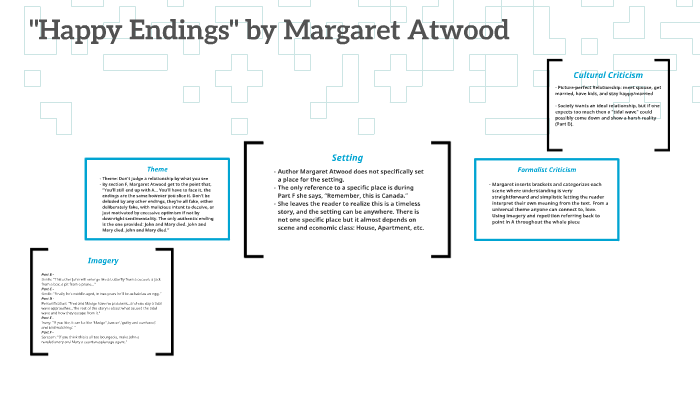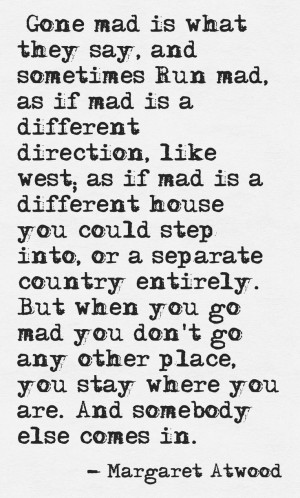

- #HAPPY ENDINGS MARGARET ATWOOD LITERARY TECHNIQUES HOW TO#
- #HAPPY ENDINGS MARGARET ATWOOD LITERARY TECHNIQUES SERIES#
This seems less interesting unless written with great skill-it is fascinating how in fiction, as in real life, evil is more interesting than good. The fifth plot involves Madge taking care of Fred during his suffering from heart disease and then doing charity work. The fourth plot is a disaster plot-Fred and Madge escape from a tidal wave. The third plot involves an affair leading to a murder-suicide, but Madge survives and marries Fred, and they live happily ever after. The other plots, involving John being a lazy hedonist whose actions lead his wife to commit suicide-and then John and his second wife Madge live happily ever after. Although the characters have a happy life, it would take a fine writer indeed to make such a plot interesting (one author who succeeds is Tony Early in Jim the Boy). It lacks conflict between the married couple, John and Mary.
#HAPPY ENDINGS MARGARET ATWOOD LITERARY TECHNIQUES SERIES#
Atwood’s work is a series of short plot summaries, beginning with the happy ending plot which, ironically, is the least interesting.

GradeSaver, 13 June 2023 Web.Margaret Atwood’s story, “Happy Endings,” is similar to Coover’s “The Babysitter.” Both works are postmodern metafiction, Both deal with the technique of writing-only with plot in the case of Atwood, but with a broader perspective in Coover.
#HAPPY ENDINGS MARGARET ATWOOD LITERARY TECHNIQUES HOW TO#
Next Section Test Yourself! - Quiz 1 Previous Section Literary Elements Buy Study Guide How To Cite in MLA Format GradeSaver "Happy Endings Essay Questions". Thus, while the story criticizes the notion that a happy ending makes a good story, it also encourages readers (and potential writers) to think about the other attributes necessary to write, and write well. Plots – and more specifically, endings – the story argues, are not as meaningful as elements like conflict, characterization, and making use of particularly enriching literary devices. However, the story presents an argument that is much more nuanced, instead suggesting that thinking about plot is only a first and rudimentary step of writing good fiction. It is easy to conclude that "Happy Endings" is a story about bad writing, bad plots, and failed fiction. What does the ultimate goal of "Happy Endings" seem to be? As such, the repetitive nature of "Happy Endings" emphasizes the changeability of fiction and the artifice involved in writing an interesting story. This repetition, then, ultimately draws attention to the concept of the writing process, as a writer attempts to puzzle through what to do with certain characters.

However, it quickly becomes clear that characters are not the same versions of themselves across the stories. Readers will notice that many words, phrases, and concepts are repeated across stories in "Happy Endings." This repetition initially fosters confusion, as it appears that each story is simply a different time in the characters' lives. Why does Atwood repeat characters' names and particular words and phrases in each of the stories? It is not the ending, then, that is important when crafting a good story. This repetition of characters' deaths connects to the narrator's concluding assertion that all stories actually have the same endings – characters die. John does not endure this and he decides to kill them. One day, John comes and finds Mary and James having sexual intercourse. Mary does not love John though, and instead loves James, who is often away riding his motorcycle. In scenario C, John and Madge are married but John and Mary are having an affair. When Mary realizes, she tries to commit suicide to attract the attention of John and make him confess his love for her but unfortunately, she dies. However, John does not take her love towards him seriously because he secretly has an affair with Madge. For instance, in scenario B, Mary is deeply in love with John. She portrays the characters in different scenarios having both good and bad endings. How does the theme of mortality manifest in "Happy Endings"?Ītwood depicts mortality as the ultimate end of every character regardless of leading a happy or bad relationship.


 0 kommentar(er)
0 kommentar(er)
